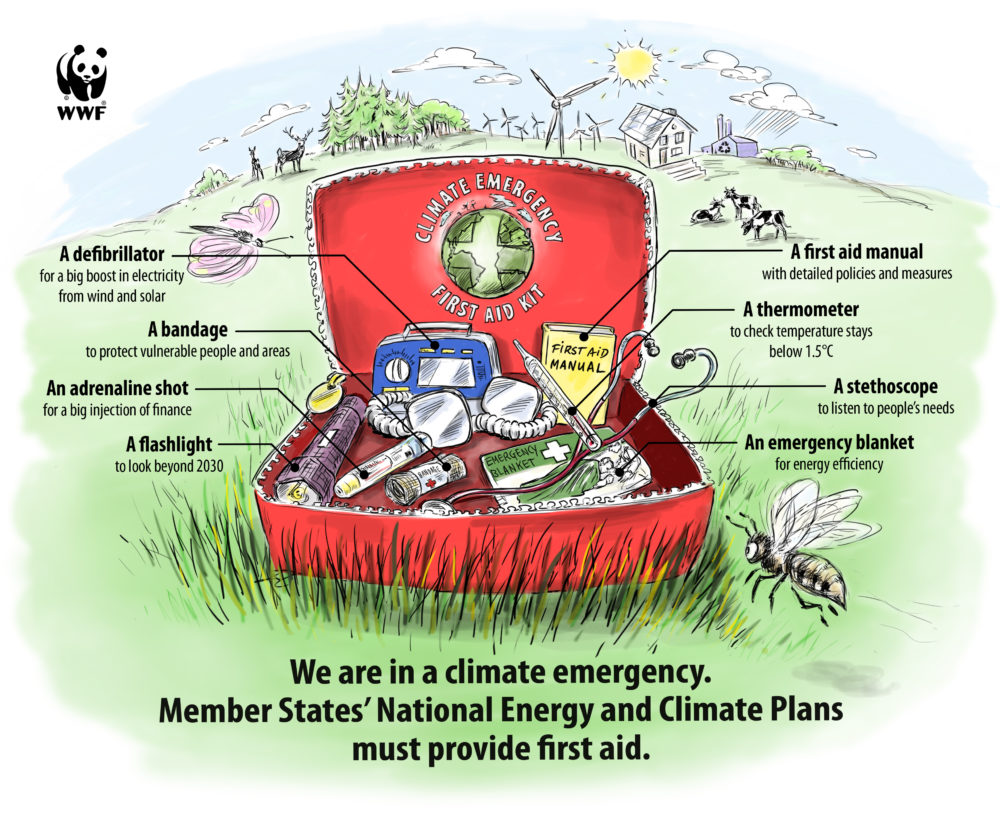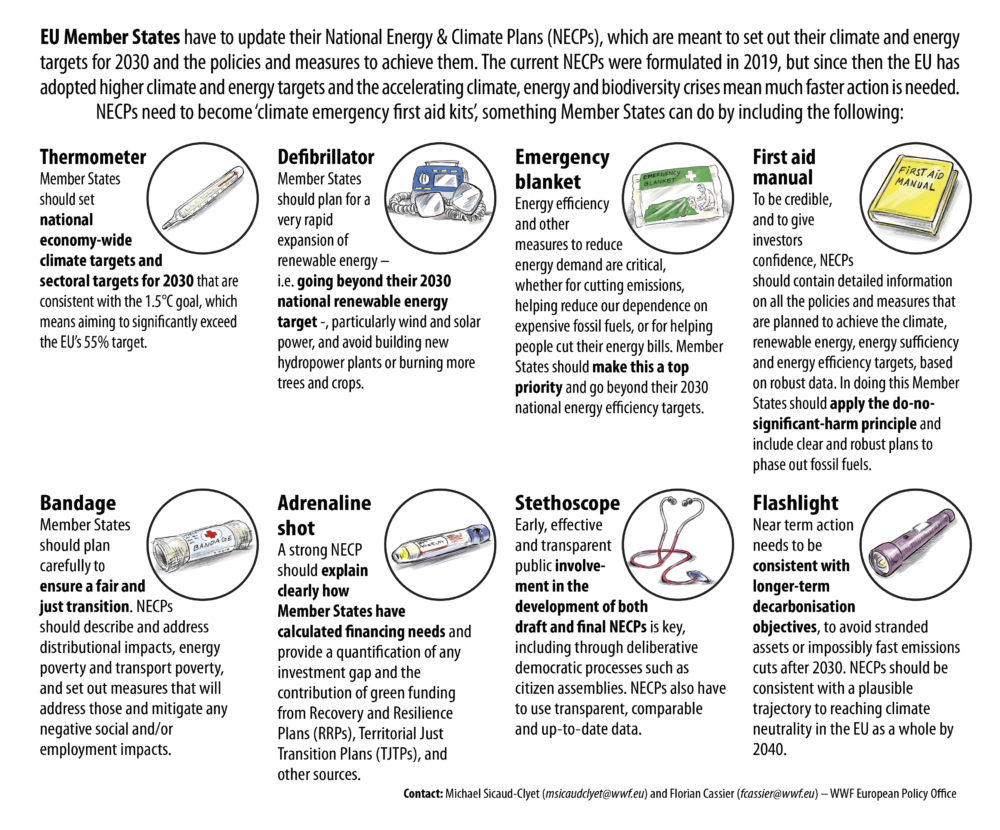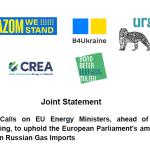“We’re close to the tipping point that will make 1.5 degrees impossible to achieve. We need an acceleration agenda and once again we count on the leadership of the European Union in this regard.” – Secretary-General of the United Nations (UN), António Guterres, 23 March 2023
The window for stopping runaway climate change is closing rapidly, the loss of ecosystems and biodiversity continues apace, and our citizens face a cost of living crisis driven by fossil fuel price increases. Against this background, the revision of Member States’ National Energy and Climate Plans (NECPs) is of paramount importance. The plans need to be key strategic planning tools to guide decarbonisation efforts at the national level in line with the 1.5°C target of the Paris Agreement, to reduce dependence on fossil fuels, and ensure a rapid and fair transition to the clean economy of the future.
In their NECPs, EU Member States are required to describe, in an integrated manner, various national climate and energy targets – as well as the policies and measures to achieve them, and the adequate funding to back them up – until 2030. But the current NECPs are dramatically unfit for purpose and need to be stronger, more comprehensive, and built on robust data and participative processes.


EU Member States can ensure this during the ongoing update process, as follows:
2030 national climate targets consistent with 1.5°C
Countries are required to include a national 2030 target for the non-ETS sectors in their NECP. The minimum level of these targets are set in the revised (unambitious) Effort-Sharing Regulation.
In a strong NECP, such targets should be considered only as the floor, not as the ceiling, and Member States should plan to exceed them significantly. In addition, to provide a complete picture on the national climate commitments, NECPs should further include:
-
- 1.5°C consistent national economy-wide climate targets for 2030, with an outlook to the longer term (see below).
- Sectoral climate targets, at least for the non-ETS sectors (buildings, transport, agriculture, waste and small industry)
Consistency with the long-term trajectory
While there is no obligation for countries to establish national targets beyond 2030, countries are required to ensure that NECPs are consistent with long-term targets, including that of the EU climate law, i.e. reaching EU-wide climate-neutrality by 2050.
A strong NECP, however, should go beyond the current EU level of ambition, taking into account and being consistent with the Paris Agreement requirements on equity. All 2030 targets should therefore be consistent with a science-based and cost-effective trajectory to reaching EU-wide climate neutrality by no later than 2040. To guarantee consistency, a strong NECP must also explain how it fits together with national Long-Term Strategies – which are currently dramatically unfit for purpose and should be revised at the same time as NECPs – and with other relevant national legislation, strategies and plans, and how all such instruments will be elaborated or revised to align with the Paris objective.
Ambitious 2030 national energy contributions
Countries are required to communicate their contribution to the binding EU-wide renewables and energy efficiency targets for 2030. Specifically, countries must include:
- A national 2030 renewable energy contribution, with trajectories and a breakdown by end-use sector and technology. Member States are also required to come up with robust sub targets for district heating and cooling, industry, buildings and transport.
- A national 2030 energy efficiency contribution, both for primary and final energy consumption.
The binding EU-wide targets are to be delivered collectively by all Member States through setting those contributions, but in a strong NECP, countries should go beyond them as they only represent the bare minimum level of ambition. Member States should put particular focus on planning how they will accelerate wind and solar energy deployment as key renewable sources to deliver the energy transition, while minimising any negative impacts on biodiversity and ensuring the full involvement of citizens and local communities.
Credible, consistent policies and measures
1.5°C compatible climate and energy targets should be backed up by credible, consistent policies and measures (PAMs). Countries are required to provide all the PAMs planned to achieve targets for (i) greenhouse gas emission reduction (at least in all non-ETS sectors), (ii) renewable energy and (iii) energy savings. Countries are also required to provide projections of the environmental and socio-economic impacts of PAMs. In the Guidelines, the Commission encourages countries to apply the ‘do-no-significant harm’ (DNSH) principle when defining PAMs.
A strong NECP, which plans for deep decarbonisation across all sectors, and for the deployment of renewables and energy saving measures, should take into consideration the latest EU policies and strategies (including Fit for 55, REPowerEU), and should be complemented by:
-
- Clear and robust plans to phase out fossil fuels from all sectors, with clear exit dates (2030 for coal, 2035 for gas and 2040 for oil, at the latest).
- A clear set of criteria to safeguard and increase national carbon sinks through nature restoration and changes to farming and forestry practices that are win-win for climate and biodiversity.
Ensure a fair and just transformation
Within the wider socio-economic impact of additional measures that countries are required to identify, they should include implications for delivering a just transition.
A strong NECP should describe and address, among other things, distributional impacts, energy poverty and transport poverty. For a strong NECP, countries should also set out measures that will ensure a fair and just transition, by tackling and mitigating any social and/or employment impacts, including labour and skills shortages. NECPS should reflect just transition processes as outlined in Territorial Just Transition Plans (TJTPs) to mitigate expected socio-economic consequences in most affected territories. A strong NECP should assess the level of energy poverty and explain how it is planned to use revenue from the Social Climate Fund to address social impacts on vulnerable households and reduce their reliance on fossil fuels.
Adequate funding for the transition
Countries are required to describe financing needs for each proposed policy and measure.
A strong NECP would also include the methodology used to calculate these financing needs, the baseline scenarios and the types of investments, as well as a quantification of the investment gap.
Countries are also required to identify the public and private funding sources used to back up planned measures– including EU funding instruments.
A strong NECP would detail the contribution of green funding, policies and measures coming from Recovery and Resilience Plans (RRPs) (including REPowerEU chapters), as well as from the Operational Programs (Cohesion policy), Territorial Just Transition Plans (TJTPs), Common Agriculture Policy (CAP) Strategic Plans, EU ETS revenues etc.
Finally, countries are also required to report on their fossil fuel subsidies and their plans to phase them out. This aspect needs to be substantially improved compared to the previous process, when reporting on fossil fuel subsidies was of low quality and included several underestimations.
A collective, transparent process
Countries are required to organise early and effective public consultations prior to the submission of draft and final NECPs. They must also establish a Multilevel Climate and Energy Dialogue to discuss energy and climate policies, including NECPs. In the plan, they must explain how such processes were conducted, and how they were taken into account. This requires a substantial improvement compared to the previous process and to the current state of play.
Countries are also required to use transparent, comparable and up-to-date data, clearly spelling out the data sources as well as the underlying methodologies used in their analysis and planning. To ensure a strong NECP process, all this information should be made publicly available and easily accessible. This is true for (but not limited to):
- GHG reduction projections up to 2040, by sector;
- WEM & WAM scenarios at least up to 2040, including 2030;
- Assessment of environmental and socio-economic impacts of PAMs
- Assessment of investment needs for planned PAMs



